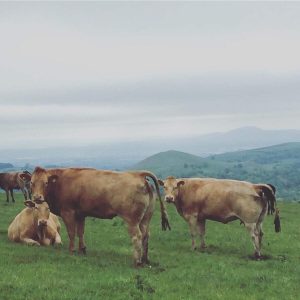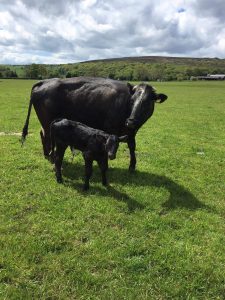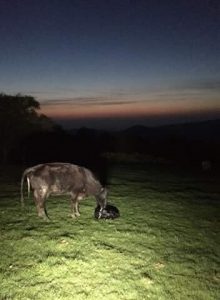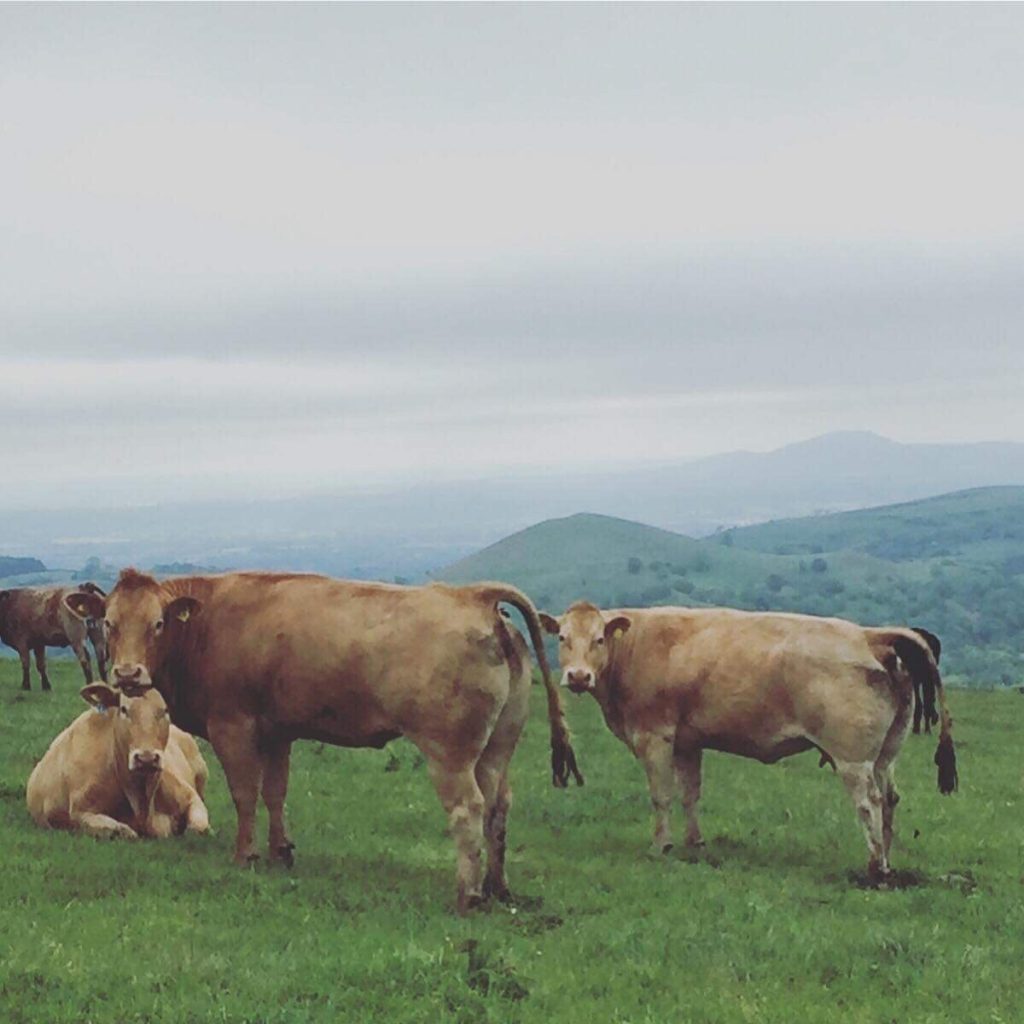Now lambing season has come to an end; the ewes are all sheared, we’ve carried out all of the work on the lambs to prevent fly strike, worms and (some strains of) pneumonia; Many of the ‘spring’ calving cows have calved and grass harvest is around the corner, we seem to have a little time for reflection on the busy period where we have welcomed new life onto our farms across the country.
 So, beginning with lambing, I can happily say that it went an awful lot better than last year! (which wouldn’t be hard!) It went so much better, that even with a considerable percentage of ewes less than the previous few years, we have the same amount of lambs. I don’t want to get too excited too soon, as there is plenty of time for sheep to find something wrong and start dying throughout the year, but it’s certainly a better start. Though some bouts of weather during April were testing, we did manage to save most lambs by bringing many couples into the building as they lambed. This sounds like a nuisance, but we decided it was better to do that, than have a shed full of sheep where only a few will actually lamb during the bad weather spells. So we kept the shed as clean and spacious as possible and as we did the rounds we just ferried them in with a little trailer (most ewes follow their lambs onto the trailer anyway making light work of it). We run the rounds of the lambing fields every 2-2.5 hours roughly, taking it in turns throughout 24 hours. Doing this enables us to catch many problems before it’s too late. It also enables us to see a lot of the predation issues we are facing. We lost more lambs to ‘predation’ than we did to the bad weather! Predation being foxes from what we witnessed. There wasn’t many evenings that one of us didn’t see a fox patrolling the lambing grounds, and although you’d have thought with us covering the ground so frequently they would be put off, they weren’t. They actually become more complacent to our presence and ballsy swiping lambs when and where they could. Knowing how rife the fox population is in our area made us realise that there is a huge threat to the ground nesting birds as well as our baby lambs. Seeing the curlew so frequently during lambing season, you can only feel sorry for them as they selected their nesting sites.
So, beginning with lambing, I can happily say that it went an awful lot better than last year! (which wouldn’t be hard!) It went so much better, that even with a considerable percentage of ewes less than the previous few years, we have the same amount of lambs. I don’t want to get too excited too soon, as there is plenty of time for sheep to find something wrong and start dying throughout the year, but it’s certainly a better start. Though some bouts of weather during April were testing, we did manage to save most lambs by bringing many couples into the building as they lambed. This sounds like a nuisance, but we decided it was better to do that, than have a shed full of sheep where only a few will actually lamb during the bad weather spells. So we kept the shed as clean and spacious as possible and as we did the rounds we just ferried them in with a little trailer (most ewes follow their lambs onto the trailer anyway making light work of it). We run the rounds of the lambing fields every 2-2.5 hours roughly, taking it in turns throughout 24 hours. Doing this enables us to catch many problems before it’s too late. It also enables us to see a lot of the predation issues we are facing. We lost more lambs to ‘predation’ than we did to the bad weather! Predation being foxes from what we witnessed. There wasn’t many evenings that one of us didn’t see a fox patrolling the lambing grounds, and although you’d have thought with us covering the ground so frequently they would be put off, they weren’t. They actually become more complacent to our presence and ballsy swiping lambs when and where they could. Knowing how rife the fox population is in our area made us realise that there is a huge threat to the ground nesting birds as well as our baby lambs. Seeing the curlew so frequently during lambing season, you can only feel sorry for them as they selected their nesting sites.
There are many benefits to patrolling the lambing grounds; another, being that we can observe what  the public are doing whilst using our land as footpaths. Watching people take pictures of the livestock and the views and appreciating our home and surroundings can remind us how lucky we are to live in such a special area. As Easter falls in lambing season, we know that the footpaths will usually be very busy (weather permitting). Following an unfortunate event last year where a young woman running released her two dogs off their leads to run through our lambing ewes, we decided to erect 6 prominent signs along the footpath leading towards the Stiperstones reserve reminding the public that dogs MUST be on leads at all times whilst passing our land. Most households have a dog and most of those take their dogs for countryside walks and again, most of those follow the code and pass peacefully with their dogs on leads. However, there is always those who do not respect the area, the livestock, the ground nesting birds or the wildlife and believe they have a special God given right to let their dog run free. So, even with over 6 signs in the space of some 1000m, we still find ourselves yelling up the hillside, to ask these people to keep their dogs on a lead! Anybody who uses social media or reads a newspaper will have seen the devastation a pet dog can be capable of with regards to livestock, but these acts of regret also damage the wildlife and can cause failure for the population of ground nesting birds that we’re trying to recover and preserve in our area, and I hope people can keep that in mind.
the public are doing whilst using our land as footpaths. Watching people take pictures of the livestock and the views and appreciating our home and surroundings can remind us how lucky we are to live in such a special area. As Easter falls in lambing season, we know that the footpaths will usually be very busy (weather permitting). Following an unfortunate event last year where a young woman running released her two dogs off their leads to run through our lambing ewes, we decided to erect 6 prominent signs along the footpath leading towards the Stiperstones reserve reminding the public that dogs MUST be on leads at all times whilst passing our land. Most households have a dog and most of those take their dogs for countryside walks and again, most of those follow the code and pass peacefully with their dogs on leads. However, there is always those who do not respect the area, the livestock, the ground nesting birds or the wildlife and believe they have a special God given right to let their dog run free. So, even with over 6 signs in the space of some 1000m, we still find ourselves yelling up the hillside, to ask these people to keep their dogs on a lead! Anybody who uses social media or reads a newspaper will have seen the devastation a pet dog can be capable of with regards to livestock, but these acts of regret also damage the wildlife and can cause failure for the population of ground nesting birds that we’re trying to recover and preserve in our area, and I hope people can keep that in mind.
 Whilst thinking of the ground nesting birds, I am reminded about an afternoon back in May, where I stood and watched whilst a curlew fought off two crows. I have taken some pictures on my phone but the quality is quite poor, but to watch this event was quite unusual. The crows took turns to fire themselves towards the curlew, who dipped and dived obstructing the birds from landing. The birds were all making a racket and eventually, the curlew won and the crows flew away. The crows didn’t fly too far away but they did leave the curlew in peace. This was all quite ironic because it was around the time where the very controversial decision inflicted by Chris Packham, to ban shooting crows, was in our headlines and although I didn’t really think it affected our practices that much, it really angered me to see first hand, the threat those birds could be on our curlews and other ground nesting birds.
Whilst thinking of the ground nesting birds, I am reminded about an afternoon back in May, where I stood and watched whilst a curlew fought off two crows. I have taken some pictures on my phone but the quality is quite poor, but to watch this event was quite unusual. The crows took turns to fire themselves towards the curlew, who dipped and dived obstructing the birds from landing. The birds were all making a racket and eventually, the curlew won and the crows flew away. The crows didn’t fly too far away but they did leave the curlew in peace. This was all quite ironic because it was around the time where the very controversial decision inflicted by Chris Packham, to ban shooting crows, was in our headlines and although I didn’t really think it affected our practices that much, it really angered me to see first hand, the threat those birds could be on our curlews and other ground nesting birds.
It’s safe to say that due to predation and the recent weather, our curlews have surely had a very tough  time and we can only be hopeful that some pairs will have managed to be successful naturally in our area. We know there were many pairs on our land and borders and we still hear them and see them but they are much quieter and secretive, which I really hope is a sign of success for the special birds and look forward to hopefully seeing some chicks appearing! We don’t mow most of our silage fields until 15th July in a bid to protect the curlew and we thoroughly hope by doing this that the population is able to increase.
time and we can only be hopeful that some pairs will have managed to be successful naturally in our area. We know there were many pairs on our land and borders and we still hear them and see them but they are much quieter and secretive, which I really hope is a sign of success for the special birds and look forward to hopefully seeing some chicks appearing! We don’t mow most of our silage fields until 15th July in a bid to protect the curlew and we thoroughly hope by doing this that the population is able to increase.
I’m already looking forward to writing again about how the rest of our calving season progresses and hopefully about how the curlew are appearing and anticipate how our harvest will come off, as well as how our summer grazing manages after we gave up 100 acres of rented ground earlier in the year.
Wishing dryer, warmer weather for everyone and a happy summertime!

